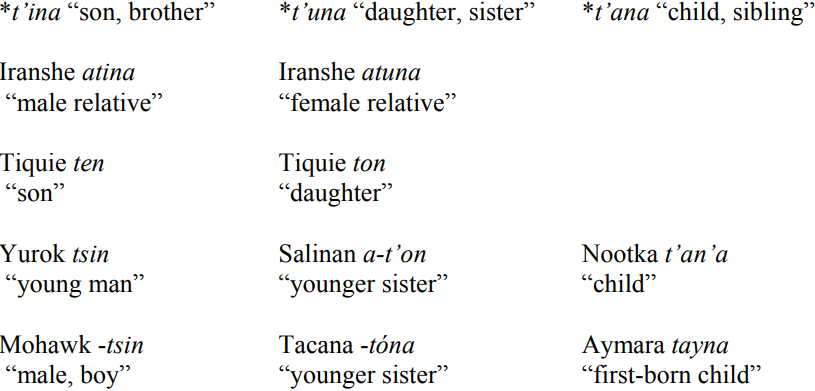


 Grammar
Grammar
 Tenses
Tenses
 Present
Present
 Past
Past
 Future
Future
 Parts Of Speech
Parts Of Speech
 Nouns
Nouns
 Verbs
Verbs
 Adverbs
Adverbs
 Adjectives
Adjectives
 Pronouns
Pronouns
 Pre Position
Pre Position
 Preposition by function
Preposition by function 
 Preposition by construction
Preposition by construction
 Conjunctions
Conjunctions
 Interjections
Interjections
 Grammar Rules
Grammar Rules
 Linguistics
Linguistics
 Semantics
Semantics
 Pragmatics
Pragmatics
 Reading Comprehension
Reading Comprehension|
Read More
Date: 2024-01-02
Date: 2024-01-23
Date: 8-3-2022
|
Smaller superfamilies: Amerind
A. Of the dozens of language groups spoken by Native Americans in the New World, Greenberg, supported by Ruhlen, classified them into just three groups: two small ones in the north, Eskimo-Aleut and Na-Dené, and an enormous one encompassing all of the others, which he called Amerind.
B. One piece of evidence for Amerind is a particular word shape referring to family members of the same age or younger than oneself, *t—na, with the vowel changing according to sex. Variations on this pattern are found throughout the New World languages and are unlikely to be accidental.
Evidence for the Amerind family:

C. Lately, genetic evidence has supported an Amerind family, showing that Native Americans’ genetic patterns differ exactly according to the three groups Greenberg identified.
D. Specialists in Native American languages have objected that the evidence for Amerind as a language group is a collection of chance correspondences and that anyone could find a similar range of chance correspondences to “prove” any classification. Ruhlen objects that it would be impossible to make a case for a *t—na root with these vowel changes from the world’s languages beyond Amerind—and he has a point.
|
|
|
|
علامات بسيطة في جسدك قد تنذر بمرض "قاتل"
|
|
|
|
|
|
|
أول صور ثلاثية الأبعاد للغدة الزعترية البشرية
|
|
|
|
|
|
|
مكتبة أمّ البنين النسويّة تصدر العدد 212 من مجلّة رياض الزهراء (عليها السلام)
|
|
|